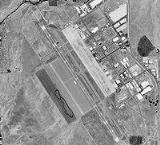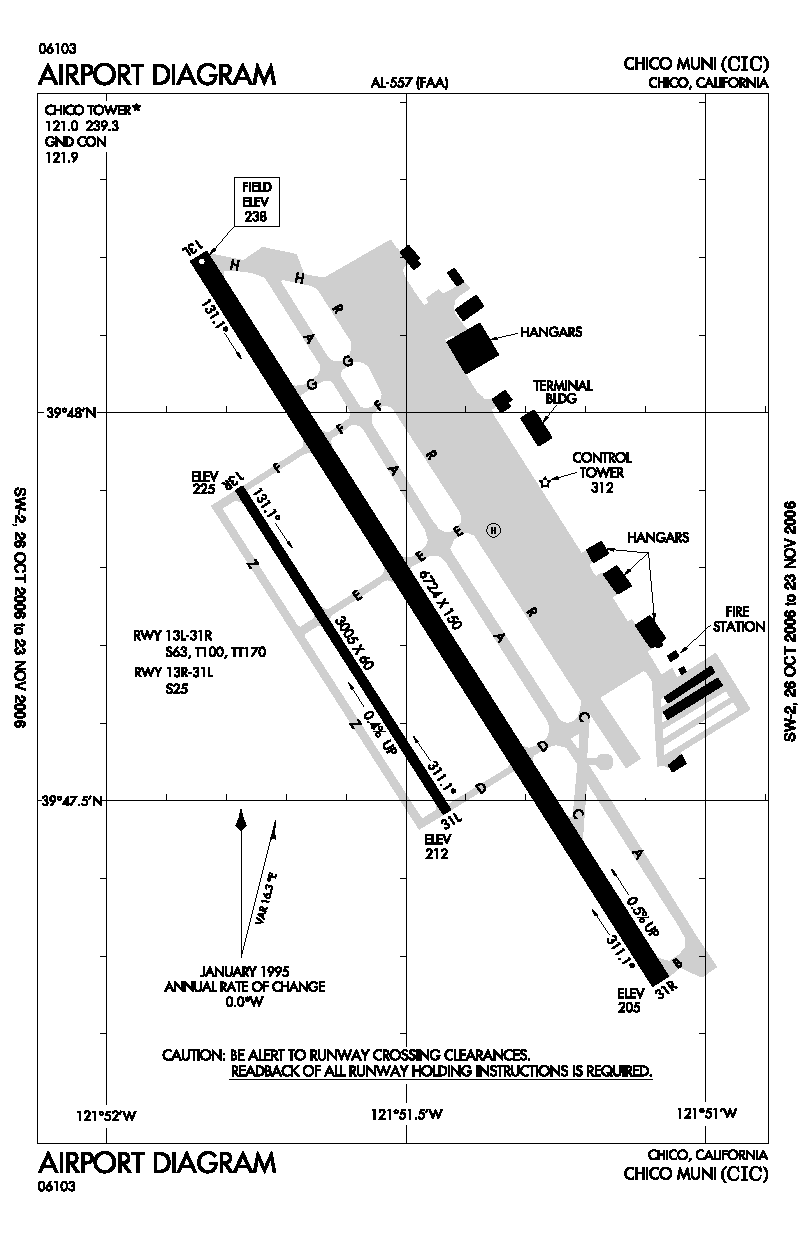
Chico Municipal Airport
Encyclopedia

Chico Municipal Airport , often called CMA, is a public airport
Airport
An airport is a location where aircraft such as fixed-wing aircraft, helicopters, and blimps take off and land. Aircraft may be stored or maintained at an airport...
located four miles (6 km) north of the central business district
Central business district
A central business district is the commercial and often geographic heart of a city. In North America this part of a city is commonly referred to as "downtown" or "city center"...
(CBD) of Chico
Chico, California
Chico is the most populous city in Butte County, California, United States. The population was 86,187 at the 2010 census, up from 59,954 at the time of the 2000 census...
, a city in Butte County, California
Butte County, California
Butte County is a county located in the Central Valley of the US state of California, north of the state capital of Sacramento. As of the 2010 census, it had a population of 220,000. The county seat is Oroville. Butte County is the "Land of Natural Wealth and Beauty."Butte County is watered by the...
, United States. The airport covers 1,475 acre
Acre
The acre is a unit of area in a number of different systems, including the imperial and U.S. customary systems. The most commonly used acres today are the international acre and, in the United States, the survey acre. The most common use of the acre is to measure tracts of land.The acre is related...
s (6 km²) and has two runway
Runway
According to ICAO a runway is a "defined rectangular area on a land aerodrome prepared for the landing and take-off of aircraft." Runways may be a man-made surface or a natural surface .- Orientation and dimensions :Runways are named by a number between 01 and 36, which is generally one tenth...
s and one helipad
Helipad
Helipad is a common abbreviation for helicopter landing pad, a landing area for helicopters. While helicopters are able to operate on a variety of relatively flat surfaces, a fabricated helipad provides a clearly marked hard surface away from obstacles where a helicopter can safely...
. It is mostly used for general aviation
General aviation
General aviation is one of the two categories of civil aviation. It refers to all flights other than military and scheduled airline and regular cargo flights, both private and commercial. General aviation flights range from gliders and powered parachutes to large, non-scheduled cargo jet flights...
, but is served by one commercial airline. The airport's fixed base operator
Fixed base operator
A Fixed-base operator or commonly abbreviated FBO is a term developed in the United States after the passage of the Air Commerce Act of 1926...
, , provides fuel, maintenance, flight training and charter flights for business and personal travel.
Airline and destination
Previous air carriers include American EagleAmerican Eagle Airlines
American Eagle Airlines is a brand name used by American Eagle Airlines, Inc. , based in Fort Worth, Texas, and Executive Airlines based in San Juan, Puerto Rico, in the operation of passenger air service as regional affiliates of American Airlines. All three airlines are wholly owned subsidiaries...
, Hughes Air West and Reno Air Express
Reno Air
Reno Air was a scheduled passenger airline headquartered in Reno, Nevada, United States.Reno Air provided service from its hubs at Reno/Tahoe International Airport in Reno, Nevada and San Jose International Airport in San Jose, California to destinations throughout the western United States, Canada...
.
History
During the late 1930s the City of Chico acquired approximately 160 acres (0.6 km²) of land five miles (8 km) north of what was then the City limits and constructed an airport hangar and runway. Until 1941, this original facility was leased to a fixed-base operator. During 1941 the City acquired an additional 1,000 acres (4 km²) for the purpose of leasing the Airport to the United States Government.On 11 September 1941 when the City Council of Chico formally signed a lease with the U.S. Army Corps of Engineers representing the War Department for the use of 1,045 acres of land at $1 per year with an option to buy. The City also provided all utilities and service roads to the field. Between four and five million dollars were allocated for construction of all needed facilities in a very short time, as at other bases. Eventually 140 buildings as well as runways, aprons and service roads were constructed.
Chico Army Airfield was under the command of the 10th Army Air Force Base Unit, AAF West Coast Training Center, Army Air Forces Training Command
Army Air Forces Training Command
Army Air Forces Training Command was a command of the United States Army Air Forces. It was redesignated Air Training Command on 1 July 1946 as part of the reorganization of the Army Air Forces after World War II....
. Chico AAF also had five auxiliary landing fields:
- Orland Auxiliary Field No. 1 39°43′16"N 122°08′44"W
- Kirkwood Auxiliary Field No. 2 39°47′20"N 122°07′31"W
- Vina Auxiliary Field No. 3 39°56′54"N 121°59′29"W
- Campbell Auxiliary Field No. 4 39°54′10"N 121°55′43"W
- Oroville Auxiliary Field No. 5 39°34′58"N 121°38′24"W
On 15 April 1942, the first cadre of permanent troops who managed the field moved in. The field was officially opened as the Chico Army Flying School on April 15, 1942. The first cadets arrived on April 25, 1942 from Moffett Field where they had already completed part of their basic flying in addition to their primary training. Basic training at Chico began on July 28,1942.
An all black company was assigned to the Field in August 1942. The first WACs arrived in October 1943. A cadre of black WACs was housed on an eleven-acre site across Cohasset Road from the Field. WASPS (Women's Army Service Pilots) frequently delivered planes to the field. At its peak Chico Army Air Field had about 4,000 personnel. In the first two years, it trained 5,500 cadets and thousands of ground personnel.
In April 1944 the mission of the Field was changed from basic flying training of cadets to training of fighter pilots. An April 24,1944 the Field was transferred from the Western Flying Training Command to the IV Fighter Command
IV Fighter Command
The IV Fighter Command is an inactive United States Air Force unit. It was last assigned to Fourth Air Force, based at Oakland Airport, California...
.
The new command brought in pilots who had completed their basic and advanced training and received commissions prior to coming to Chico. Here they were to be taught tactics of combat flying using Bell King Cobra (P-63) planes, later switching to the twin-engine Lockheed P-38 Lightings. These were all propeller planes. In May of 1945 jet training was introduced on the P-59 jet trainers, and in July the P-51 `Mustangs. On August 25, 1945 IV Fighter Command was replaced by the 21st Bombardment Wing. Its function was to process both personnel and aircraft for overseas assignment. In October 1945 the Wing was redesignated the First Staging Command. Now the planes being processed were B-29 Superfortress bombers and crews.
Chico Army Air Field was deactivated on December 31, 1945. The property was excessed and transferred by the U.S. Army to the General Services Administration (GSA) for disposal. The lease on 1,045.3 acres was terminated on June 8, 1948. The lease termination agreement included the transfer of all U.S. Government constructed improvements to the City of Chico. GSA transferred the 10.97 acres to the City of Chico by deed dated January 28, 1949. The total acreage disposed was 1,056.27.
On 30 January 1959, the Air Force announced plans to conduct surveys in the vicinity of Beale Air Force Base to determine the feasibility for missile bases. A Titan-I
Titan I
The Martin Marietta SM-68A/HGM-25A Titan I was the United States' first multistage ICBM . Incorporating the latest design technology when designed and manufactured, the Titan I provided an additional nuclear deterrent to complement the U.S. Air Force's SM-65 Atlas missile...
ICBM
Intercontinental ballistic missile
An intercontinental ballistic missile is a ballistic missile with a long range typically designed for nuclear weapons delivery...
was located on the north side of the airport from 1962–1965, part of the Beale AFB's
Beale Air Force Base
Beale Air Force Base is a United States Air Force base located approximately east of Marysville, California. Originally known as Camp Beale....
851st Strategic Missile Squadron system of several ICBMs centered around Marysville. Its formal designation was Beale 851-C. The last missile was lowered into the Chico complex 4C on April 20, 1962.
The Chico missile complex was the location of two 1962 accidents. On 24 May during a contractor checkout, a terrific blast rocked launcher 1 at the complex, destroying a Titan I and causing heavy damage to the silo. On 6 June trouble again struck as a flash fire at another silo killed a worker. After the investigation, the Air Force concluded that the two separate explosions occurred because of a blocked vent and blocked valve. The silo was repaired and put back into operational service. Today, the site has all three launch silos capped, but some development has taken place on the launch area with a retention pond, some trees, and some single-story buildings being erected. It appears to be in use for some type of quarrying/grading material which is transported to construction sites in the Chico area.

